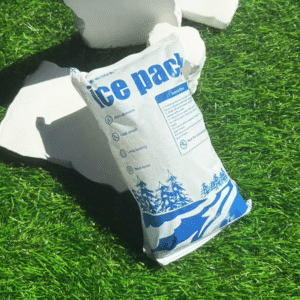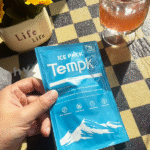El envío de productos perecederos a todo el país requiere una planificación cuidadosa, especialmente cuando paquetes de hielo seco are involved. hielo seco, la forma sólida de dióxido de carbono, se sublima directamente en gas a -78,5°C (-109.3°F), making it an ideal coolant for maintaining sub-zero temperatures during transit. Sin embargo, improper handling, embalaje, or failure to meet regulatory requirements can lead to spoilage, safety hazards, or non-compliance. This guide provides you with the latest best practices for shipping with dry ice packs, the necessary regulatory updates, and safety tips to ensure smooth operations.
-
What are dry ice packs and how do they work for shipping cross-country?
-
How can dry ice packs maintain the required temperature during long-distance shipments?
-
What are the benefits of using dry ice for shipping perishable goods across the country?
-
How can businesses effectively implement dry ice in their logistics for cross-country shipments?
What Are Dry Ice Packs and How Do They Work for Shipping Cross-Country?
Dry ice packs are solidified carbon dioxide (Co₂) used to keep perishable items frozen during transport. A diferencia del hielo tradicional, El hielo seco se sublima directamente en gas., eliminating any risk of water damage. This unique property makes dry ice especially valuable in shipping temperature-sensitive goods like food, productos farmaceuticos, y productos de biotecnología. During a cross-country shipment, the cooling effect of dry ice ensures that products are kept at the required temperature until they reach their destination.
Dry ice sublimates at a consistent rate, which helps in maintaining cold temperatures for an extended period, typically between 24–48 hours depending on the amount used and the insulation quality. For cross-country shipments, this duration is generally sufficient to ensure that goods remain frozen or chilled without any risk of spoilage.
How Dry Ice Packs Maintain Temperature During Long-Distance Shipments
The process of sublimation is the key to dry ice’s effectiveness in temperature control. As solid CO₂ turns into gas, it absorbs heat from the surrounding environment, thereby keeping the interior of the package cold. This gradual and consistent cooling effect ensures that products remain within the desired temperature range without the risk of thawing or spoilage during transport.
For cross-country shipments, where deliveries can take 24–72 hours, dry ice is the preferred choice due to its ability to maintain sub-zero temperatures over extended periods.
| Método de control de temperatura | Periodo de tiempo | Eficacia | Aplicación práctica |
|---|---|---|---|
| Paquetes de hielo seco | 24-48 horas | Alto | Ideal para larga distancia, productos sensibles a la temperatura |
| Paquetes de gel | Varía | Moderado | Best for short distances or less sensitive items |
| Paquetes de hielo | Varía | Bajo a moderado | Suitable for sturdier products with some tolerance for temperature fluctuations |
¿Cuáles son los beneficios del uso de hielo seco en el envío de la cadena de frío??
Dry ice is widely regarded as one of the most effective cooling methods for temperature-sensitive shipments. The benefits of using dry ice include:
Control de temperatura eficiente
Dry ice offers unparalleled cooling power, keeping goods frozen at temperatures as low as -78.5°C (-109.3°F). This makes it ideal for shipping perishable food, vacunas, and medical supplies that need to remain frozen during transit. A diferencia del hielo tradicional, El hielo seco se sublima en gas, leaving no liquid residue and preventing potential contamination.
Poder de enfriamiento duradero
Dry ice can maintain sub-zero temperatures for a significant period, haciéndolo perfecto para envíos de larga distancia. The ability to keep products frozen for up to 48 hours ensures that even long-haul cross-country shipments can maintain their integrity without the risk of thawing.
Rentabilidad
Although dry ice may initially appear expensive, it is often more cost-effective than other methods. By reducing spoilage and maintaining product quality, businesses can lower overall shipping costs and minimize losses from product damage.
Best Practices for Packing Dry Ice for Cross-Country Shipping
Proper packing is essential to ensure the safe and efficient transport of goods with dry ice. Below are the best practices for packing dry ice for cross-country shipments:
-
Select Appropriate Packaging Materials:
-
Contenedor exterior: Use rigid, vented containers such as corrugated cardboard boxes to allow CO₂ gas to escape. Avoid airtight seals that could lead to pressure buildup.
-
Aislamiento: Choose insulation materials like polystyrene foam or thermal liners to reduce sublimation rates and maintain temperature.
-
Caza de focas: Secure the seams of your packaging using the H-taping method to ensure it remains intact during transit.
-
-
Properly Arrange Contents:
-
Capas: Place a layer of dry ice at the bottom of the container and another layer on top of the product.
-
Espaciado: Fill any voids with packing materials such as bubble wrap or packing peanuts to prevent movement and minimize sublimation.
-
-
Etiquetado y Documentación:
-
Marcas: Etiquete claramente el paquete con “Hielo seco” o “Dióxido de carbono, Sólido,” Y 1845, and indicate the net weight of the dry ice in kilograms.
-
Etiqueta de peligro: Attach a Class 9 hazard label for air shipments to ensure proper handling during transport.
-
Regulatory Requirements for Shipping Dry Ice
El cumplimiento de la normativa marítima vigente es fundamental para garantizar un transporte seguro y legal.
Envío Nacional (A NOSOTROS.)
-
Transporte aéreo: Los envíos de hielo seco por vía aérea están regulados como materiales peligrosos. El peso máximo permitido por paquete es 5 libras (2.27 kilos) para transporte aéreo.
-
Embalaje: Se deben utilizar recipientes ventilados para evitar la acumulación de presión..
-
Etiquetado: Los paquetes deben incluir la ONU. 1845 etiqueta, peso neto en kilogramos, y una clase 9 etiqueta de peligro.
Envío internacional
-
Documentación: Para envíos internacionales, Es posible que se requiera una declaración del remitente para mercancías peligrosas..
-
Políticas del transportista: Verifique siempre los requisitos y restricciones específicos del transportista..
Tendencias futuras en el envío de hielo seco para 2025
A medida que evoluciona la industria naviera, Varias tendencias están dando forma al futuro de la logística del hielo seco.:
-
Sostenibilidad en el embalaje: Crece el uso de materiales biodegradables y reciclables para reducir el impacto ambiental de los envases.
-
Monitoreo inteligente: The integration of IoT devices for real-time temperature and location tracking provides enhanced visibility and control over shipments.
-
Actualizaciones regulatorias: Continuous updates to shipping regulations ensure improved safety and efficiency.
Conclusión y recomendaciones
Shipping perishable goods with dry ice requires careful attention to packaging, etiquetado, y cumplimiento regulatorio. By following best practices and staying informed about industry trends, businesses can ensure that their temperature-sensitive shipments are delivered safely and efficiently.
Siguientes pasos
-
Evaluate your shipment profile: Consider the nature of the goods and the shipping method (aire o tierra) that best suits your needs.
-
Optimize packaging and insulation: Choose materials that will maintain the required temperature for the duration of the shipment.
-
Manténgase actualizado sobre las regulaciones: Ensure that your team is well-informed about the latest shipping regulations and safety protocols.
Acerca de Tempk
Y tempk, Nos especializamos en brindar soluciones innovadoras de cadena de frío., incluidas bolsas de hielo seco de alta calidad. Our products are designed to meet the stringent requirements of various industries, ensuring the safe and efficient transport of temperature-sensitive goods. Para más información o para realizar un pedido, visit our website or contact our customer service team.























